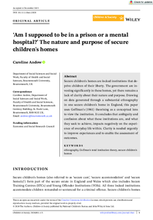Secure children's homes are locked institutions that deprive children of their liberty. The government are investing significantly in these homes, yet there remains a lack of clarity about their nature and purpose. Drawing on data generated through a substantial ethnography in one secure children's home in England, this paper uses Goffman's (1961) theorising as a conceptual lens to view the institution.
It concludes that ambiguity and confusion about what these institutions are, and what they seek to achieve, impacts negatively on the experience of everyday life within. Clarity is needed urgently to improve experiences and to enable the assessment of outcomes.

